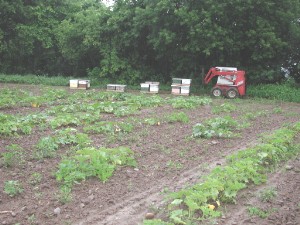Pollination management
|
|
Pollination Management is the label for horticultural practices that accomplish or enhance pollination of a crop, to improve yield or quality, by understanding of the particular crop's pollination needs, and by knowledgeable management of pollenizers, pollinators, and pollination conditions.
| Contents |
Pollinator decline
With the decline of both wild and domestic pollinator populations, pollination management is becoming an increasingly important part of horticulture. Factors that cause the loss of pollinators include pesticide misuse, unprofitability of beekeeping for honey, rapid transfer of pests and diseases to new areas of the globe, urban/suburban development, changing crop patterns, clearcut logging (particularly when mixed forests are replaced by monoculture pine), clearing of hedgerows and other wild areas, loss of nectar corridors for migratory pollinators, and human paranoia of stinging insects (killer bee hype).
In 1989, following Hurricane Hugo, massive aerial applications for mosquitoes were done in South Carolina. The following year, watermelon growers who did not place beehives in the fields, observed the fruit begin to develop, then abort, or develop into small deformed fruit. There were entire fields that never yielded a single usable melon. Some growers went out of business; others began to seriously manage pollination. Since beekeepers were also heavily damaged by the mosquito spraying, the supply of bees for pollination was critically short for several years.
Importance of pollination management
The increasing size of fields and orchards (monoculture) increase the importance of pollination management. Monoculture can cause a brief period when pollinators have more food resources than they can use, while other periods of the year can bring starvation or pesticide contamination of food sources. Most pollinator species rely on a steady nectar source and pollen source throughout the growing season to build up their numbers.
Plumpollen0060.jpg
Honeybees are especially well adapted
to collecting and moving pollen,
thus are the most commonly used pollinators
Crops that traditionally have had managed pollination include apple, almonds, pears, some plum and cherry varieties, blueberries, cranberries, cucumbers, cantaloupe, watermelon, alfalfa seeds, onion seeds, and many others. Some crops that have traditionally depended entirely on chance pollination by wild pollinators need pollination management nowadays to make a profitable crop.
Types of pollinators
Organisms that are currently being used as pollinators in managed pollination are honeybees, bumblebees, alfalfa leafcutter bees, orchard mason bees, and fuzzyfooted bees. Other species are expected to be added to this list as this field develops. Humans also can be pollinators, as the garderer who hand pollinates her squash blossoms, or the Middle Eastern farmer, who climbs his date palms to pollinate them.
Extension recommends one honeybee hive per acre (4,000 m² per hive) for standard watermelon varieties to meet this crop's pollination needs. In the past, when fields were small, pollination was accomplished by a mix of bees kept on farms, bumblebees, carpenter bees, feral honeybees in hollow trees and other insects. Today, with melons planted in large tracts, the grower may no longer have hives on the farm; he may have poisoned many of the pollinators by spraying blooming cotton; he may have logged off the woods, removing hollow trees that provided homes for bees, and pushed out the hedgerows that were home for solitary native bees and other pollinating insects.
Planning for improved pollination
Before pollination needs were understood, orchardists often planted entire blocks of apples on a single variety. Because apples are self sterile, and a variety is a genetic clone (equivalent to a single plant) this is not a good idea. Growers now supply pollenizers, by planting crab apples interspersed in the rows, or by grafting crab apple limbs on some trees. Pollenizers can also be supplies by putting drum bouquets of crab apples or a compatible apple variety in the orchard blocks.
The field of pollination management cannot be placed wholly within any other field, because it bridges several fields. It draws from horticulture, apiculture, zoology (especially entomology), ecology, and botany.

